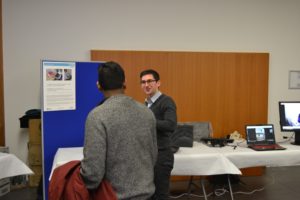On Thursday last week, Designability gave their 50th Annual Lecture, which this year celebrated a fantastic 50 years of developing assistive and enabling technologies. You can check out the highlights of the event on Twitter, but read on for my summary of the event.
On the Evening
The lecture itself was jointly given by three professors, who talked about the work of Designability in the past, present, and future. The audience enjoyed hearing about what Designability does at the lecture, which has previously been given by external speakers.
Before the lecture, Designability's President, the Right Honourable the Lord Don Foster of Bath, gave an enthusiastic introduction and talked about the products Designability has developed over the years. The lecture was followed by a thank you from Gavin Maggs, a Designability trustee, who also made an appeal for donations to help Designability continue their work as they raise money to complete the funding for a move to a new building.
The Past
The first part of the lecture was given by Professor Roger Orpwood, who is a former director of Designability. His talk focused on how the difficult part of designing assistive technology lies in the user interface, in how the product will be used by the people for whom it is being designed. It is imperative to include end users from the outset, in order to avoid missing important aspects of the design.
One example was an early prototype of a bedroom lamp that automatically turns on and off in the night when someone gets out of bed. After getting up and the light switching on, as expected, the person returned to the bedroom to take off their dressing gown, but sat down on the bed to suddenly find the lights had gone off. They stood back up again and the lights came back on! Without testing the design with real people, this small design problem had been missed.
Professor Orpwood also highlighted some of the needs of people living with dementia from a previous engagement study, which will be useful for my project. One of the outcomes was that it is important for people with dementia to have access to support to complete tasks in the home. This is what my project hopes to achieve using new technology, though I will make sure to involve end users as soon as I have a prototype that is ready to be iterated.
The Present
Professor Nigel Harris, the current Chief Executive of Designability, then went on to talk about the importance of designing technology that makes people feel happy to use it. Assistive technology should still look appealing and should not stigmatise those who use it.
I have seen first-hand how this concept pervades the design principles at Designability, so I have a great role model for when I come to designing technology to support people living with dementia.
The Future
Finally, Professor Praminda Caleb-Solly, Head of Electronics, talked about how robotic assistance could be the future of assistive technology. She showed how the form of assistive robots can range from being relatively simple and small to help with social aspects of ageing, such as a robot pet to help with loneliness or agitation, up to larger, more complex systems that are able to help with all tasks at home, like getting up from a chair or carrying a tray from the kitchen to the dining room.
Although mainstream adoption of robotics may still be 10-15 years away, some robotic technology is out there already and will become more acceptable with time. To emphasise how she envisions robotics being able to support independent living, Professor Caleb-Solly recited a poem she had written explaining how her work is developing robotics that help, not hinder, freeing up time for people to spend with their loved ones now that the care aspect is carried out by robots.
The Exhibition
There was also an exhibition space for people to explore before and after the lecture, in which Designability products were showcased. I showed off the HoloLens, and lots of people came to ask me about my project. I was so pleased with their positive comments, and had some interesting conversations with people about how similar ideas could help other people with physical or cognitive difficulties.

All-in-all, it was a very successful evening and everyone involved had a great time. Although the lecture was about celebrating the past 50 years of outstanding work carried out by Designability, I feel privileged to be a part of the next 50 years to come.
Thank you, Designability!
Respond
